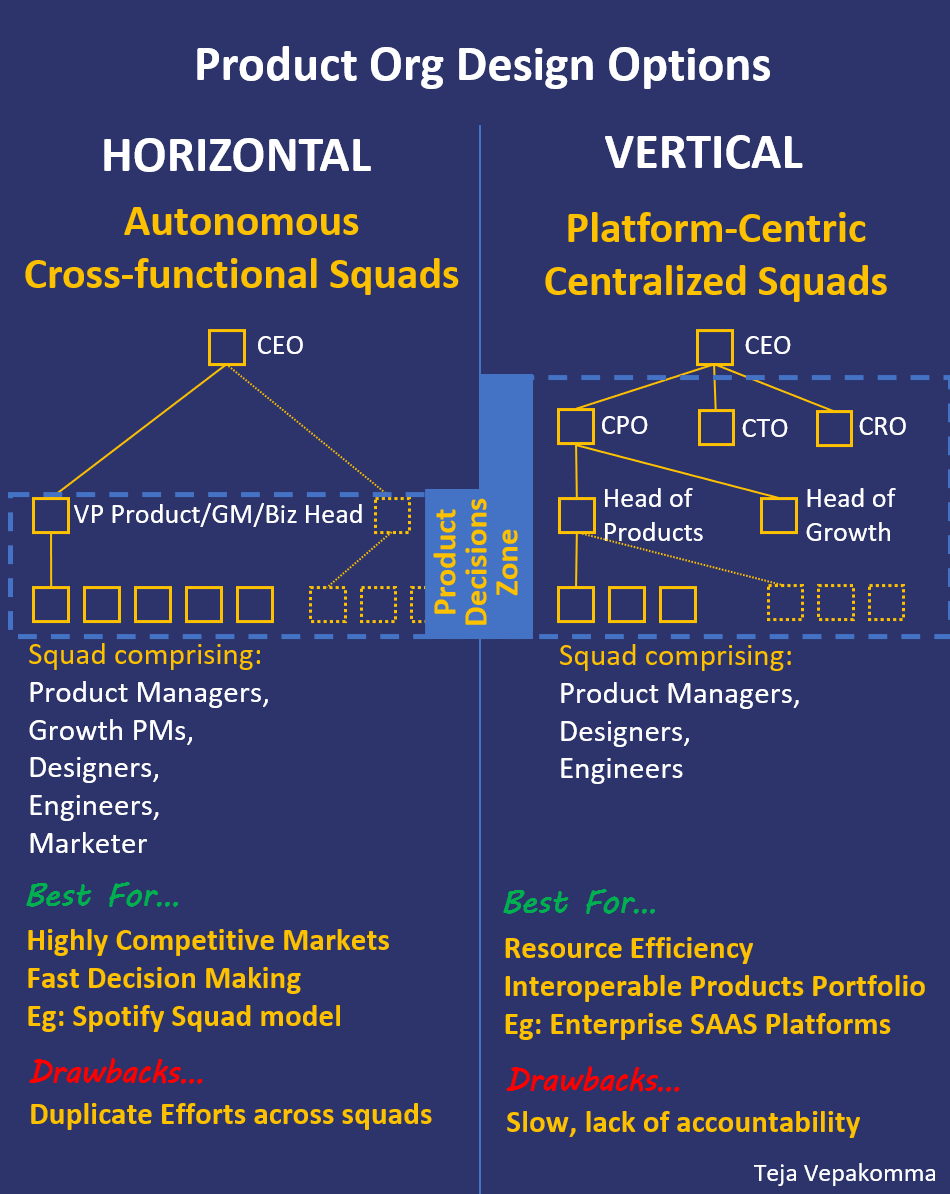The Hidden Lever of Growth: How Org Structure Drives (or Kills) Products
With real examples from Spotify, Apple, Amazon and Google
It is surprising how much organizational structure shapes product and business outcomes. Yet, many founders and leadership teams treat it as an afterthought.
In reality, the way you design your product organization often decides whether your company can move fast, adapt to customers, and scale effectively—or whether it gets stuck in internal bottlenecks.
The right org design depends on three key factors: market competitiveness, product portfolio strategy, and the tradeoff between decision speed and organizational efficiency.
Let’s unpack these with real-world examples.
1. Market Competitiveness: Speed Requires Autonomy
In highly competitive industries, where customer expectations shift quickly, teams cannot afford to wait for approvals from layers of hierarchy.
Horizontal structures (see figure) —where decision-making authority is pushed down to autonomous squads—work best in these environments.
Each squad must be self-contained: product, engineering, design, marketing, and growth roles embedded together.
Decisions on features, growth experiments, and customer feedback happen directly inside the squad.
Spotify is a classic example of a horizontal org structure. Its Squad model empowered small, autonomous teams to experiment rapidly with recommendations, playlists, and sharing features. This allowed Spotify to outpace bigger players like Apple in delivering personalized music experiences. The org structure itself became a competitive advantage.
2. Product Portfolio Strategy: Alignment Requires Centralization
If your company has multiple products sold to the same customers or market segments, a more vertical structure becomes critical. This is shown on the right hand side of the figure.
Why? Because the portfolio of products must work seamlessly together. Customers don’t buy products in isolation—they evaluate the bundle, pricing, and overall value.
In this case, CXOs (see figure) need authority to ensure products complement each other as well as integrate seamlessly
Decision-making must be centralized to align bundling, cross-product integration, and roadmap priorities.
Apple is a perfect illustration of a vertical org structure. Its highly centralized org structure ensures products like the iPhone, iPad, and Mac are tightly integrated. Features like Air Pods switching seamlessly between devices or iCloud syncing across the ecosystem are only possible because portfolio-level leadership aligns design and engineering choices. Without centralization, the Apple ecosystem would feel fragmented instead of seamless.
3. Decision Speed vs. Org Efficiency: Finding the Balance
Every org design faces the classic tradeoff:
Vertical (centralized) structures → Slower decision-making, but higher efficiency through teams that avoid duplication and reuse shared platforms and infrastructure.
Horizontal (autonomous) structures → Faster decision-making, but less efficient. Squads may duplicate efforts, rebuilding similar modules in parallel.
Amazon demonstrates how to balance this tradeoff. It introduced the famous “two-pizza teams” concept. i.e. A team should be small enough that it can be fed with two pizzas (usually 6–10 people). This gave squads autonomy to innovate in retail, cloud, and devices. At the same time, Amazon built centralized platforms like AWS infrastructure, payments, and logistics that all teams could leverage. This hybrid structure created both speed (autonomous teams) and efficiency (shared resources)—allowing Amazon to scale across multiple industries without collapsing under complexity.
4. Why Generative AI Products Need Horizontal Structures
Generative AI products are still in fast-evolving markets. Success depends on:
Close collaboration with customers to refine outputs, usability, and trust.
Cross-functional squads that bring together product, engineering, design, and growth (adoption).
A Horizontal structure empowers teams to run rapid iterations, respond to feedback, and adapt quickly.
This is why many AI-first startups organize into small, nimble squads, rather than traditional vertical hierarchies. Centralized decision-making would slow them down in markets that demand speed. Unfortunately, in larger organizations, leadership tends to get involved in AI products as there is keen interest to monitor progress. But this makes it harder for larger organizations to move faster with Generative AI.
5. The Hybrid Reality: Most Companies Sit In-Between
Very few organizations can run fully horizontal or fully vertical structures. The ideal design often sits somewhere in between:
Cross-functional squads for speed and autonomy.
Light vertical oversight for portfolio alignment and shared infrastructure.
Matrix elements (like security, compliance, or GDPR initiatives) that cut across squads.
Google illustrates this hybrid approach well. While product teams operate with autonomy, a matrix structure ensures organization-wide initiatives like privacy, compliance, and AI ethics are applied consistently across Search, YouTube, Ads, and Cloud. The tradeoff: some decisions move slower. But the payoff is global consistency and trust across products that billions use.
Final Takeaway
Your org structure is not just an internal design choice—it is a strategic lever. It determines whether your company innovates quickly, scales effectively, and delivers customer value.
The right structure depends on:
How competitive your market is,
The nature of your product portfolio, and
Whether you need speed or efficiency
Get this wrong, and even the best product strategy will struggle to deliver results. Get it right, and you unlock both growth and resilience.
Need to discuss your organizational design with me? Message me on Linkedin.
About the Author
Teja Vepakomma is a Product Strategy and Growth consultant to companies. He has many years of experience working in Product Management leadership roles in Global SAAS companies. He’s currently based in Bangalore, India. You can follow or reach out to him on LinkedIn.


